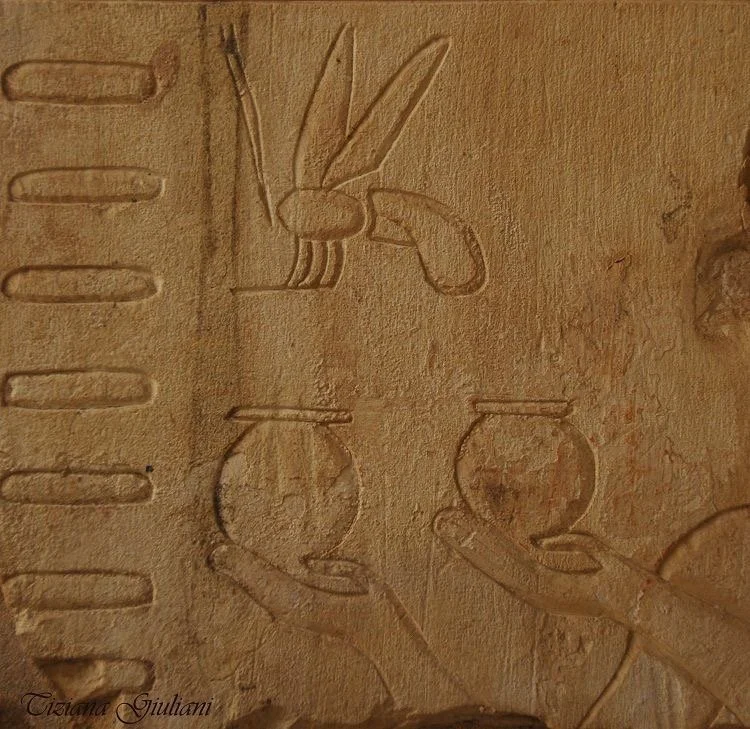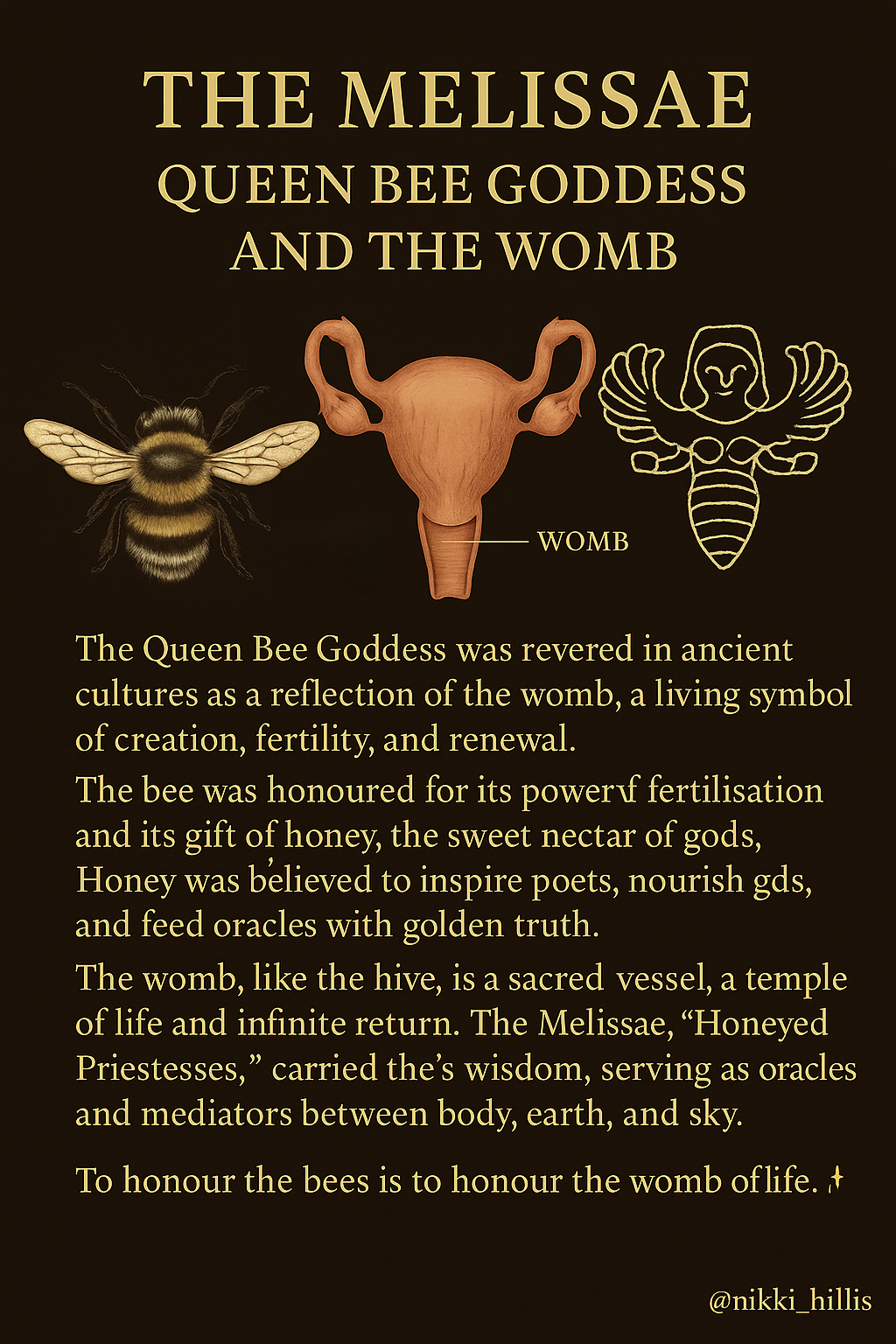Reconnecting with the Bee Priestess and Melissae
On this World Honey Bee Day, we honour not only the bees who sustain our ecosystems but also the ancient priestesses who carried their wisdom: the Melissae. These “bee priestesses” appear across cultures and myths as oracles, healers, and mediators between realms. Their presence lingers in story, ritual memory, and even in the ways bees still meet us today, buzzing above our heads, circling the heart, and reminding us of the harmony that binds all life.
Origins of the Melissae
The name Melissa comes from the ancient Greek μέλισσα (melissa), meaning “honeybee.” Its root, meli (μέλι), means “honey.” This was never a casual name. It tied priestesses directly to the sacred essence of honey and to the qualities of the honeybee — fertility, purity, prophecy, community, and sweetness.
Singular: Melissa = honeybee
Plural: Melissae (Latinized) or melissai in Greek = honeybees
The connection was so profound that plants beloved by bees, like Melissa officinalis (lemon balm) — were named for them. In mythology, the title “Melissa” was given to priestesses of Demeter, Persephone, Artemis, Cybele, and Aphrodite, and sometimes even to the goddesses themselves.
Some traditions trace their beginnings to the Meliades, ash-tree nymphs born from the blood of Ouranos when Cronus struck him down at Gaia’s urging. From his blood the Meliades arose, while from seafoam Aphrodite emerged. Earth and water gave birth together, and bees, as winged pollinators, completed the triad by representing air. The Melissae inherited this balance of earth, sea, and sky, serving as priestesses who could cross thresholds between worlds.
The Melissae Across Cultures
The reverence for bees and their priestesses was not unique to Greece:
In Egypt, bees were believed to be born from the tears of Ra. The temple of Neith was called the “House of the Bee.”
In India’s Rig-Veda, bees were symbols of divine speech and inspiration.
The Celts linked bees to the goddess Brigid, who was said to have brought them from her orchard in the Otherworld.
In Minoan Crete, bees appeared on sacred rings and ritual offerings, bound to fertility and renewal.
Wherever the bee was honored, women bearing its name and wisdom were present.
Myths of the Honeyed Ones
The Melissae hum through many Greek myths:
Melissa the nymph discovered honey and taught humans how to mix it with water, perhaps the earliest form of mead.
Another Melissa secretly fed honey to the infant Zeus while he was hidden from Cronus. When Cronus discovered her, he turned her into a worm; Zeus, in gratitude, transformed her into a bee.
Persephone, goddess of spring and queen of the underworld, was known as Melitodes, “the honeyed one.”
Honey itself was treated as sacred: food of the gods, a gift of prophecy, and a golden thread weaving life, death, and rebirth.
The Melissae as Priestesses
Bee priestesses served in temples and sanctuaries across the ancient Mediterranean:
Eleusis: The Melissae guided the Mysteries of Demeter and Persephone, sacred rites that revealed the continuity of life beyond death.
Delphi: Oracular priestesses were called Melissae. The poet Pindar described prophecy as “the voice of the Delphic Bee.” In the Homeric Hymns, Apollo himself confesses that he learned the art of prophecy from three bee-maidens dwelling in the caves of Mount Parnassos. They lived on honeycomb, and when they tasted the gods’ golden food, their words rang true; without it, their visions faltered. Honey was thus understood as a conduit of truth and divine inspiration.
One of these three was said to be Daphne, whose name means “laurel.” Long before Apollo claimed Delphi, she was revered as an oracle-nymph on the mountain. Later, the high priestess of Apollo’s temple, the Pythia was often called the Delphic Bee, a living echo of those original Melissae. Even the sacred Omphalos stone where the oracle sat resembles a woven bee skep swarming with life, the hive itself as the seat of prophecy.
Anatolia: Cybele’s priestesses also bore the name Melissae. Later, under Rome, they were known as Mellonia’s attendants, priestesses of the goddess of honey.
Artemis: Queen of the Bees
Among the goddesses, Artemis held one of the deepest associations with bees. She was revered as both the “Queen Bee”and the “Mistress of the Wild Bees.”
Her great temple at Ephesus, one of the Seven Wonders of the Ancient World was tended by Melissae who served her in rituals that reflected the hive’s balance and order. As a lunar goddess, Artemis embodied periodic regeneration, the cycles of waxing and waning, birth and return.
Some traditions held that bees were the very souls of women descending from Artemis herself. The hive became a reflection of her power: feminine, fertile, and endlessly renewing. To serve Artemis as a Melissa was to embody the sacred rhythms of nature, fertility guided by the moon, harmony patterned after the bees’ eternal dance.
Honey as Divine Inspiration
Much like the bees themselves, honey was a conduit of divine blessing, inspiration, and truth. The Melissae were said to have nurtured both Zeus and Dionysos with honey in infancy, feeding the young gods with the earth’s sweetest gift.
The Muses, too, were believed to bestow honey on the lips of poets, singers, and philosophers. Plato, Homer, and Sappho were all said to have been “honey-fed” as infants, just as the gods were, their eloquence literally flavoured by the bees.
Honey-water and mead were likely among the very first libations poured to the ancestors. Some even suggest that Ambrosia, the fabled food of the gods, was none other than golden honey.
Bee Priestesses and the Hive
The Melissae mirrored the hive they served. Like bees, they lived in devotion to community, balance, and creation. Their drumming echoed the hum of wings; their spiral dances mirrored the flight of foraging bees; their rituals followed the cycles of sun, moon, and bloom.
The waggle dance of bees, a figure-of-eight pattern used to share the location of nectar, was more than communication. To the ancients, it was a living infinity symbol (∞), representing endless renewal and the weaving of life with death.
For the Melissae, this mirrored their sacred role as soul midwives, guiding spirits into birth, death, and rebirth. Like bees, they traced eternity with their movements, reminding humanity of life’s unbroken cycle.
Symbolism of Bees and the Melissae
Bees and their priestesses carried a constellation of meanings:
Fertility & abundance – linking flower, field, and harvest.
Prophecy & truth – honey as the food of poets and oracles.
Cycles of life & death – Persephone’s descent mirrored in the swarm and return.
Interconnectedness – each being essential to the hive of life.
Infinity & balance – the waggle dance’s figure-eight, a sign of eternal renewal.
Bees in Ceremony and Healing
This wisdom is not only mythic, it is alive today. In ceremony, meditation, or healing work in nature, bees often arrive as allies. They may hover over the crown, circle the heart, or tone softly near a chakra, their buzzing felt as an energetic blessing.
Their presence feels less like chance and more like guidance, a form of attunement to the subtle harmonies of the world. Just as the Melissae once sang with bees and carried prophecy through their hum, bees today can still act as healers, weaving their vibration into our own and reminding us of the song beneath creation.
The Melissae’s Legacy
When Christianity spread across the Roman Empire, the Melissae’s voices were silenced. Emperor Theodosius closed the temples in 391 CE, and their rites were forced into secrecy. Yet their wisdom endured. In Ephesus and elsewhere, devotion to the Great Mother transformed into the image of the Black Madonna, ensuring the bee priestess survived in hidden form.
Their knowledge was never lost, only buried, pressed into caves, folded into honey, whispered through plants, and carried in the hum of bees, waiting to be remembered.
Honoring Bees Today
To honour bees, and the Melissae, is to weave ancient wisdom into modern life.
Plant bee-friendly flowers in gardens, balconies, and windowsills.
Create habitats for solitary and social bees, leave bare soil, hollow stems, or bee hotels.
Avoid pesticides that harm pollinators and advocate for ecological practices.
Support ethical, sustainable beekeepers and consume bee products mindfully.
Create a space of reverence: offer bowls of honey, light beeswax candles, or display bee symbols like hexagons, carved wax figures, miniature skeps, or art.
By tending to bees in this way, we keep alive the legacy of the Melissae, ensuring that the hum of the hive, both physical and spiritual, endures for generations.
The Melissae remind us that bees are more than pollinators, they are keepers of memory, prophets of truth, and teachers of infinity. Their wings sketch eternity into the air, their honey carries blessing, and their hum is the music of harmony itself.
On this day, may we taste honey as divine food, hear the vibration of bees as blessing, and remember what the Melissae once knew: to live in rhythm with the hive is to live in rhythm with the world.



